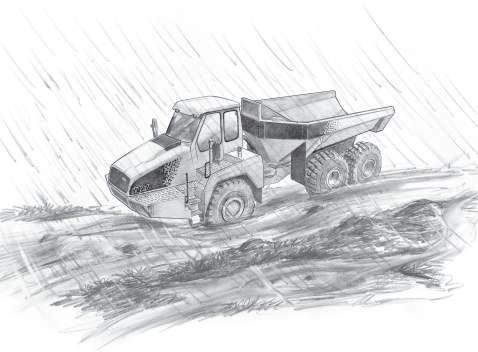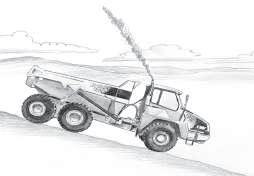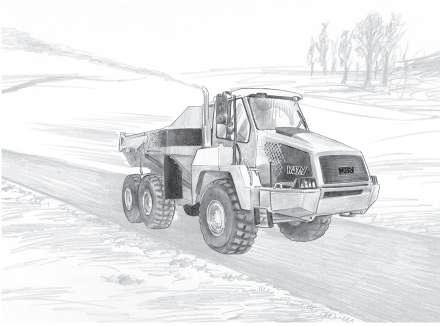
6 minute read
Precautions on work sites
from Daewoo Doosan ADT MT25 MT26 MT31 MT36 MT41 Operation and Maintenance Manual MX519828 - PDF DOWNLOAD
There are many different types of work sites, some of them could be: • Dusty areas • Altitude above 1000 m • Underground areas (mines) • Rocky areas • Steep driving • Transit, long distance drive-away (more than • Wet, swampy or muddy areas • Extremely hot areas 3 km) • Seashore or salty areas • Extremely cold areas
Rules and guidelines are listed below to increase the lifetime of the dump truck. Pay attention to these guidelines and let the safety always get fi rst priority.
General • On work sites where extra heavy-duty operations are occurring, reduce the maintenance intervals and carry out greasing more frequently. • Clean the machine regularly. Keep grease fi ttings, breathers and oil level gauges clean and avoid dirt to enter these items.
Dusty areas/Underground areas (mines) • When working in dusty/sandy work sites or work sites where the service brake (foot brake) is frequently used, check the brake lining more often, at least every 250 hours (see 500 hours service for procedure). • Watch the air fi lter warning light, to see whether the engine air filter is clogged. Clean/replace the engine air fi lter at shorter intervals than specifi ed, clean as often as necessary (see 1000 hours service for procedure). Extremely dusty applications may require to clean the air filter every day! • Clean the radiator core frequently, every week if necessary, to avoid clogging (see 500 hours service for procedure). • Clean and replace the fuel fi lters frequently (see 1000 hours service for procedure). • Check daily the cab ventilation fi lter and pre-fi lter. These fi lters will very soon be clogged in dusty areas, therefore it is necessary to clean and replace the cab ventilation fi lter and pre-fi lter more frequently than usual (see 40 and 500 hours service for procedure). Never remove a fi lter element/pre-fi lter without replacing it with a new one! • Clean electrical components, especially the starting motor and alternator, to avoid accumulation of dust.

Rocky areas • Inspect the pinion bearings more often when working in rocky areas (see 1000 hours service for procedure), and replace the bearings as often as necessary, i.e. if the bearings shows signs of wear, cracks or damages. • Check for damage to the undercarriage and for looseness, flaws, wear and damage in wheel bolts and nuts. • Check tyres for damage and wear. Remove foreign object from the threads as soon as possible, these will sooner or later penetrate into the tyre. Also protect the tyres from falling stones during loading.



Wet, swampy or muddy areas (see also chapter 2, item 15 - Wading) • Be aware of that the braking effect will be reduced when the brakes are wet. • The brake linings must be checked more often, at least every 250 hours, when driving in wet or swampy areas (see 500 hours service for procedure), the wear of the lining will in- crease. • The wear of the sealings will also increase when driving in wet or swampy areas, check and replace sealings as often as necessary. • If mud sticks to the callipers or discs, and the brakes are left in that condition, the wear of the lining will increase, therefore always wash the area well with water after operations. E.g. when clay is dried up it is hard as concrete, this will cause breakage and wear of the machine. • Do not let the water fl ow through the grill or into the differ- ent breathers and air fi lters. • Do not operate the dump truck in water/rivers permanently for a long period.
And do not under no circumstances let the water fl ow through the grill.
Seashore or salty areas • Before star t working, check plugs and valves for tightness. • Spray exposed areas with anti-corrosive. • Check the brake linings more often (see 500 hours service for procedure). When driving in wet salty/sandy areas the wear of the lining will increase. • Check also the sealings more often, the wear will increase in salty/sandy areas. • Lubricate components more frequently than usual. • Do not operate the dump truck in water permanently for a long period.
And do not under no circumstances let the water fl ow through the grill. • It is important to wash the machine immediately after the work to protect the components for rusting and to remove dirt and sand.
See also item above "Wet, swampy or muddy areas"
High altitude (above 2000 m) • Be aware of that the engine power and torque will be reduced due to low air density. Contact your Dealer for possible remedy. • Do not remove the air fi lter!


Steep driving • Always when driving downhill and loaded, use only the exhaust and retarder brake for retarding. The service brake (foot brake) must only be used for complete stop. (see also chapter 2, item 13 - Operation of brakes and chapter 5, item 2.12 - Up, down and cross gradient travel) • See also engine and retarder brake capacity chart at chapter 8.
Extremely hot areas • Watch the engine coolant temperature gauge, the engine coolant temperature warning light and the transmission oil temperature gauge. If the temperatures are at the limit, check the engine radiator for clogging (see 500 hours service) • Watch the air fi lter warning light, to see whether the engine air fi lter is clogged. Clean/replace the engine air fi lter at shorter intervals than specifi ed, clean as often as necessary (see 1000 hours service for procedure).


Extremely cold areas (see also chapter 5, item 7 - Cold weather) • Use engine heater • Check that the correct oils are used (see oil specifi cation sheet, chapter 6) • Check that there is enough glycol in the coolant (see 2000 hours service for freezing point and correct coolant)
Transit, long distance drive-away (more than 3 km) • Check and adjust the tyre pressure on cold tyres before starting. Do not reduce pressure during driving. • Generally replace the mineral based oil with fully synthetic oil. A mineral based oil have a rapid break down of lubrication ability and cooling ability when operated at high temperatures (120OC). Replacing mineral based oil with a synthetic oil will improve the cooling capacity by 15%. • Make sure that the interaxle differential is disconnected when driving, as the 50/50 torque split will generate a lot of heat. • Drive only without load. • Drive 2 hours and stop for minimum 30 min. Drive another 2 hours and stop for minimum 1 hour. Repeat. • Upper speed limit for this operation: 2000 rpm at 6. gear. Must not be exceeded!








